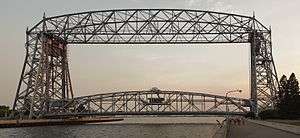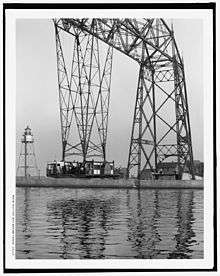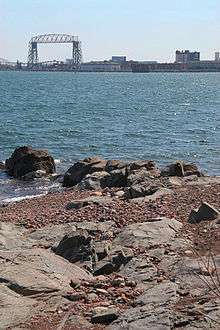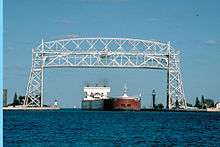Aerial Lift Bridge
The Aerial Lift Bridge, earlier known as the Aerial Bridge or Aerial Ferry Bridge, is a landmark in the port city of Duluth, Minnesota. The span began life in 1905 as the United States' first transporter bridge: Only one other was ever constructed in the country, Sky Ride in Chicago.[2] The span was converted in 1929–1930 to a vertical-lift bridge — also rather uncommon, although there are six such bridges along Ontario's Welland Canal — and continues to operate today. The bridge was added to the National Register of Historic Places on May 22, 1973. The bridge is owned and operated by the City of Duluth. The United States Army Corps of Engineers maintains a nearby maritime museum.
Aerial Lift Bridge | |
 Aerial Lift Bridge in 2007 | |
| Location | Lake Avenue, Duluth, Minn. |
|---|---|
| Coordinates | 46°46′44.5″N 92°5′33.9″W |
| Built | 1905, reconstructed in 1929 |
| Architect | Thomas F. McGilvray; C.A.P. Turner |
| NRHP reference No. | 73002174 [1] |
| Added to NRHP | May 22, 1973 |
Bridge history

The bridge spans the Duluth Ship Canal, which was put through the miles-long sand spit named Minnesota Point — commonly called Park Point by locals — in 1870–1871. The natural mouth of the Saint Louis River is about seven miles (11 km) farther southeast, and is split between Minnesota and Wisconsin. Creating this gap in the sand spit meant that residents who lived on the new island needed to have a way to get across. Several transportation methods were tried, though they were complicated by the weather. Ferries could work in the summer, but ice caused problems in colder months. A swinging footbridge was used, but was considered rather rickety and unsafe.
In 1892, a contest was held to find a solution. The winning design came from John Low Waddell, who drew up plans for a high-rise vertical lift bridge. The city of Duluth was eager to build the bridge, which would have been about 130 feet (40 m) wide. However, the War Department objected to the design, and the project was canceled before it could be built. Waddell's design went on to be built in Chicago, Illinois, as the slightly larger South Halsted Street Bridge, which was removed in 1932.[3][4][5]
New plans were later drawn up for a structure that would ferry people from one side to the other. This type of span, known variously as an aerial transfer, ferry, or transporter bridge, was first demonstrated in Bilbao's Vizcaya Bridge in 1893 and one in France in 1898. Duluth's bridge was inspired by the one in France, though the actual construction is quite different. The architect was a city engineer, Thomas McGilvray.[1]

When it was completed in 1905, the Aerial Bridge's gondola had a capacity of 60 short tons (54 tonnes) and could carry 350 people plus wagons, streetcars or automobiles. A trip across the canal took about one minute, and the ferry car moved across once every five minutes during busy times of the day.[6] A growing population on Minnesota Point, a greater demand for cars, and an increase in tourism soon meant that the bridge's capacity was being stretched to the limit.
A remodeling was planned that would remove the gondola and incorporate a lifting platform into the structure. The firm finally commissioned with designing the new bridge was the descendant of Waddell's company. The new design, which closely resembles the 1892 concept, is attributed to C.A.P. Turner. Reconstruction began in 1929.[1] In order to ensure that tall ships could still pass under the bridge, the top span had to be raised to accommodate the new deck when raised. The support columns on either side were also modified so that they could hold new counterweights to balance the weight of the lifting portion. The new bridge first lifted for a vessel on March 29, 1930.[6]
The bridge can be raised to its full height of 135 feet in about a minute, and is raised about 5,000 times per year.[7] The span is about 390 feet (120 meters). As ships pass, there is a customary horn-blowing sequence that is copied back. The bridge's "horn" is actually made up of two Westinghouse Airbrake locomotive horns.[8] Long-short-short is known as the Captain's Salute and is the most common of the ship signal exchanges.
Gallery
 The Aerial Bridge in 1905
The Aerial Bridge in 1905 The bridge in 2007
The bridge in 2007 The Aerial Lift Bridge at Night. (2007)
The Aerial Lift Bridge at Night. (2007) Raised, with the lake freighter the Edgar B. Speer a self-discharging bulk carrier, passing through the channel
Raised, with the lake freighter the Edgar B. Speer a self-discharging bulk carrier, passing through the channel MV Edwin H. Gott under the Aerial Lift Bridge
MV Edwin H. Gott under the Aerial Lift Bridge
See also
- Transporter bridge — other similar bridges in the world
- Tees Newport Bridge
- John A. Blatnik Bridge — the nearby Interstate 535 crossing in Duluth–Superior
- Richard I. Bong Memorial Bridge — the nearby U.S. Route 2 crossing
- Sky Ride — the other ferry bridge built in the U.S. as an exhibit at the 1933–1934 World's Fair, "Century of Progress," in Chicago
- South Halsted Street Bridge — Waddell's bridge design as built in Chicago
- Stillwater Bridge (St. Croix River) — another lift bridge in Minnesota, connecting to Wisconsin
References
- "National Register Information System". National Register of Historic Places. National Park Service. January 23, 2007.
- "Strange Span: 1907". Shorpy.com.
- Encyclopedia of Chicago: Halsted Street Vertical Lift Bridge, 1894-1932 Archived June 23, 2010, at the Wayback Machine
- Minnesota Historical Society, Minnesota's Historic Bridges:Stillwater Bridge, 2009 Archived December 16, 2004, at the Wayback Machine - includes Duluth, Chicago detail
- Leonardo Fernández Troyano, Bridge engineering: a global perspective. Thomas Telford, 2003, p.728. ISBN 0-7277-3215-3. Includes Halstead bridge photo
- Duluth Public Library, 2007 - many more photos
- GmbH, Emporis. "Duluth Aerial Lift Bridge, Duluth - 239407 - EMPORIS". www.emporis.com.
- Beamer, Ryan (10 April 2014). "Ups & Downs: My 8 Years Operating Duluth's Aerial Lift Bridge".
- Fulton Klinkerfues. Duluth struggled to find its lift bridge. Good Age Newspaper. Accessed December 19, 2004.
- Aerial Lift Bridge. A Minnesota Sampler. Minnesota Historical Society. Accessed December 19, 2004.
- Larry Oakes (July 14, 2002). Duluth's Aerial Lift Bridge a defining symbol. Star Tribune. Accessed December 19, 2004.
External links
| Wikimedia Commons has media related to Aerial Lift Bridge. |
- Architecture and History of the Duluth Aerial Lift Bridge
- Duluth Aerial Lift Bridge Library of Congress, Historical American Engineering Record, Survey number HAER MN-44
- Aerial Lift Bridge at Structurae
- James Baughn and contributors, Historic Bridges of the United States:Duluth Aerial Lift Bridge
- Bridge raising video

